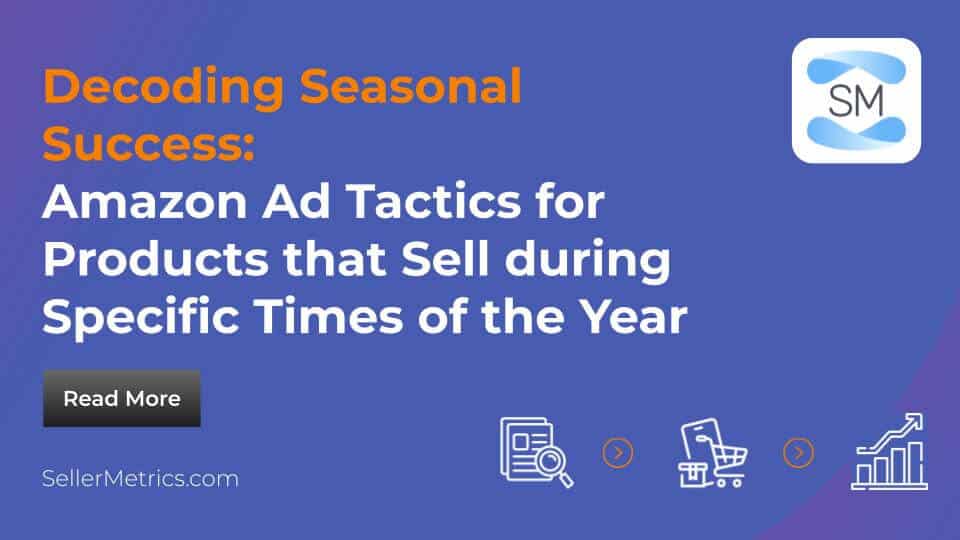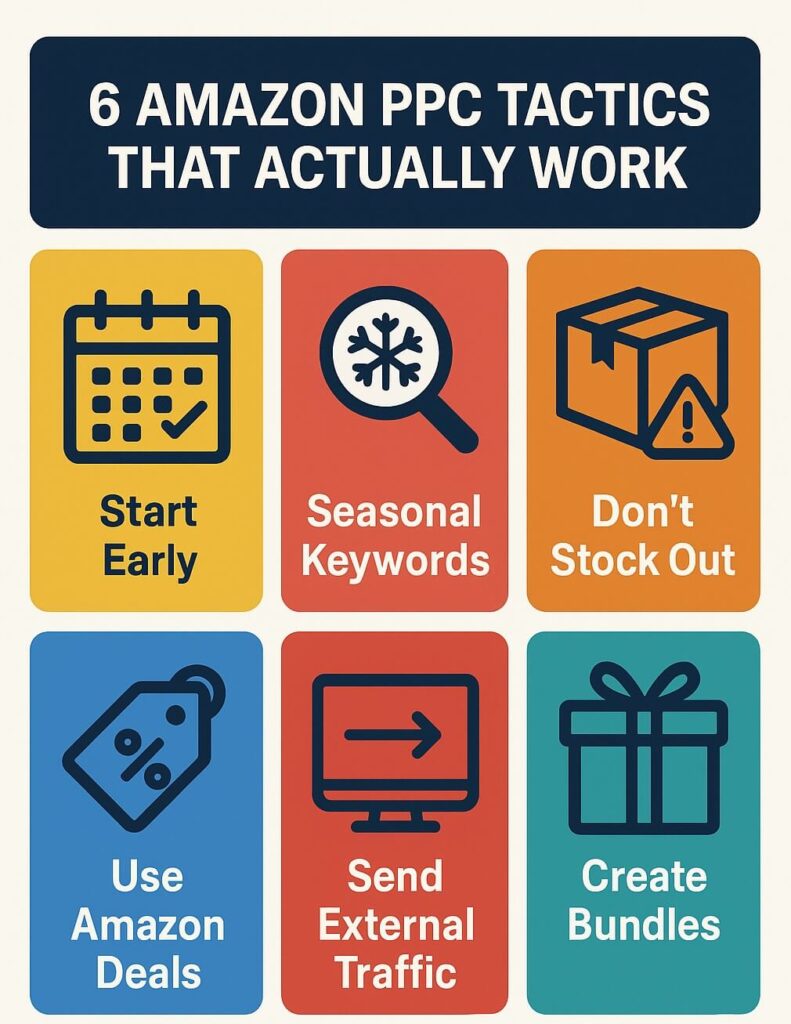18 October 2025
How to Stop Search Query Cannibalization in Amazon Ads
TweetLinkedInShareEmailPrint What Is Search Query Cannibalization in Amazon Ads? Search query cannibalizati...

Article Contents

Some products just aren’t meant to sell year-round. No one’s buying pool floats in December or snow boots in July, unless people are going on a vacation or something weird is going on. The truth is that seasonal products have their moment. When you hit that window right, things take off.
On Amazon, timing is everything. One week you’re on top of the search, the next you’re buried under a pile of competitors who got their act together just a little earlier. That’s because seasonal demand doesn’t rise gradually. It spikes. Fast. And when it does, ad costs go up, clicks become a battle, and sellers who planned ahead usually win the game.
This guide will walk you through how to spot those seasonal waves, prep your ads, and avoid the “Wait… is it already too late?” feeling. With the right strategy, your seasonal product can do more than sell. It can steal the spotlight. For more information, please read the articles
The best-performing seasonal products tend to follow the same patterns every year. The key is knowing when those waves of demand actually hit, so you’re ready before the competition.

Things start to pick up in September, especially once Halloween decorations start popping up in every aisle (and probably in your neighbor’s yard). Costumes, creepy decor, candy bowls shaped like skulls, you name it. These start flying off the shelves by mid-September.
As soon as the chill sets in, shopping habits change fast. People start reaching for anything that keeps them warm: coats, heaters, cozy socks, and blankets you could probably disappear under for the whole weekend. If it fends off the cold, it’s gonna sell.
Then comes the grand finale: the holiday shopping season. From Black Friday through Christmas, it’s game on. Shoppers are in gift mode, scooping up everything from gadgets and toys to kitchen gear and twinkly home decor. Basically, if it fits in wrapping paper, it’s fair game.
Spring kicks off a new kind of shopping mood. From April to June, people are all about getting outside. Garden tools, patio furniture, and new ice popsicle molds, if it helps them enjoy the weather, it’s in demand for sure.
This is also when travel picks up. Whether they’re going off on a grand adventure, a weekend jaunt, or are simply going to the nearest splash pad park, people begin scouring for bags, beach towels, swimsuits, and sunscreen the instant they catch a whiff of summer in the air.
Allergy season doesn’t miss a beat either. Products like air purifiers and antihistamines see a steady rise as pollen fills the air.
May and June turn into a full-blown celebration season. Between graduations and weddings, shoppers are out hunting for gifts, keepsakes, party favors, anything that says “congrats” or “happily ever after.” If your product fits the occasion, it’s your time to shine.

The weather doesn’t just decide what people wear, it pretty much decides what they buy, too. One chilly weekend, and suddenly everyone’s panic-ordering space heaters and burrito-sized blankets. Give them a bit of sun, and they’re all about new beach towels and picnic gear like summer’s already here.
Pay attention to resources such as NOAA, Weather Underground, or even Google Trends – look at what the weather was like when your ad clicks or sales began to escalate. The sooner you catch the trend, the sooner you can get ahead of consumer before your competition even takes their umbrellas out.
Days that guarantee a shopping rush: Back-to-School, Spring Break, Mother’s Day, Fourth of July, Black Friday, and Cyber Monday – literally everyone is online hunting for deals.
A couple of tools that help to know exactly when they’re coming:
Next, evaluate your own historical Amazon PPC and sales data by following these precise steps:
Once you’ve got those dates down, go back and peek at your Amazon data from previous years. Check how your ads performed in the lead-up to each one. You can use various Amazon PPC tools to track spikes in impressions, clicks, or keyword performance across those key shopping dates. Did clicks jump around Back-to-School? Was there a lift in impressions before Valentine’s Day? Take note of what worked and, just as importantly, what didn’t.
The Wayback Machine (archive.org/web) lets you check out old versions of almost any website. It’s a handy way to see when your competitors started rolling out their seasonal promos and what kind of messaging or offers they used at the time.
Here’s how to utilize it for your Amazon strategy:
Think about the brands or sellers that always seem to be everywhere during busy seasons. They usually show up at the top, running slick promos, maybe even beating you to the punch last year. If they’re consistently active when seasonal demand picks up, note them down.
Go to the Wayback Machine and paste in the URL of their homepage (or any landing page you think they’ve used for promos). You’ll get a calendar of snapshots showing what their site looked like on different dates. Click through to the months before peak seasons like September through November for holiday shopping or April to June for summer campaigns.
Pick a few dates from past seasons and browse their site like you’re just snooping around. Did they start doing gift-themed products in October? Did the homepage suddenly switch to reds, greens, and snowflakes? Look for the small stuff, like updated product names, new images, maybe even a line about “perfect for the holidays.”
Open a spreadsheet and put down what you find:
Now go back into your Amazon reports and check:
Once you’ve got the data, use it to build a smarter strategy for this year:


Holiday shoppers have a lot of people to shop for, and they’re ready to buy. If your product listings aren’t ready by then, you’re probably going to miss out. Many sellers make the mistake of waiting until November to start prepping, but by then, it’s already too late. October is the sweet spot, it’s when people start poking around, filling up carts, and planning.
Now’s the time to go over your listings and make them feel more gift-worthy. That might mean tweaking your titles or bullet points so they highlight why your product makes a good present. Maybe it’s practical, fun, or fits a certain type of person – make that clear.
Show your product in a way that makes it feel giftable, like under a tree, peeking out of a stocking, or just wrapped up with a bow. Doesn’t really have to be fancy. Even a quick video of someone unboxing it or using it at a holiday get-together helps people imagine it in their own plans. Tweak your keywords to be “Holiday-ready” like gifts for dad, stocking stuffer for teens, or holiday gifts under $25. If your listing shows up early for those searches, you’ve got a better shot once traffic picks up.
Amazon offers you plenty of options to create the right seasonal promo: Lightning Deals, Coupons, and Prime Exclusive Discounts.
While others wait for peak days, run deals in early to mid-November to get ahead of the noise.
And don’t separate your promos from your ads. If you’re running PPC ads for “gifts under $50,” stack a coupon on top. That combo says it all: it’s a deal, it’s in season, and it’s worth grabbing now.
A little holiday creativity can go a long way. Use Amazon Posts to show your product in real-life scenes, like slipped into a stocking, under a tree, or part of the holiday table. Keep it casual and relatable, like something out of someone’s home, not a catalog.
Short videos work, too. A quick clip of your product being wrapped or unboxed can help shoppers imagine giving it as a gift. Even better if you make it feel personal, like a “gift for teachers” or “perfect for holiday hosts.” These small touches can make your listing feel more warm, festive, and worth clicking.
Seasonal selling takes more than a few keyword tweaks. Here’s where sellers often get it wrong:
Seasonal wins aren’t about getting lucky. They’re about noticing the patterns, showing up early, and being ready when people start searching. These trends repeat, year after year. The sellers who pay attention are usually the ones who stay ahead.
You’ve done this before. Check what worked last year, watch what your competitors are up to, and trust your gut when testing something new. Not every campaign will be a win, and that’s fine. Each season gives you a better shot at the next one.
Just don’t wait around. Start early, stay flexible, and keep things moving. The busy season doesn’t last long, but the results can.
About 4-6 weeks before the season really kicks in.
Sponsored Products campaigns are your bread and butter!
See how much your clicks or sales jumped from your past seasonal data, then put your budget by at least 25-40% to account for higher CPCs and heavier traffic.
That’s unfortunate, but you can instead focus on retargeting, smart cross-sells, and high-intent keywords.
Yes. A good seasonal push can have lasting effects.